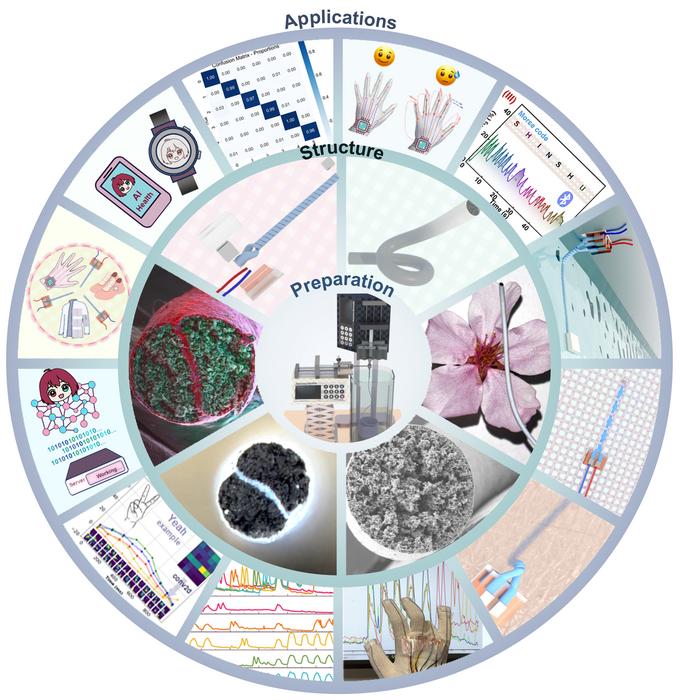
Researchers from Shinshu University have unveiled a groundbreaking advancement in wearable technology, showcasing a new flexible fiber sensor modeled after the intricate structure of DNA. This innovative device, designed with a double-helical shape, fundamentally changes the way fiber sensors operate, effectively addressing durability issues that have long plagued conventional wearable sensors. Traditional designs that place electrodes at both ends have consistently been vulnerable to failure due to the stresses applied during movement, particularly at body joints where flexibility and sensitivity are paramount.
The newly developed sensor moves away from this methodology by consolidating both electrodes to one end, thus significantly enhancing its robustness. This design adaptation allows the sensor to withstand the forces associated with repeated stretching and bending, making it particularly suitable for applications on human joints where frequent motion is inevitable. It is a significant step forward towards achieving reliable and fully functional wearable devices capable of monitoring movements in real-time without the risk of disconnection or failure.
The researchers drew inspiration from the stability and resilience of DNA’s double helix structure. The double-helical design not only provides an aesthetically appealing look but also introduces a level of mechanical stability that traditional straight fiber sensors lack. By twisting two specially crafted coaxial fibers together, the researchers created a stable framework that is both lightweight and functional. This breakthrough indicates a new era where durability and flexibility can coexist harmoniously in wearable technology.
Constructed using a coaxial wet-spinning process, the dual-fiber structure utilizes an insulating outer layer and a conductive inner core. The core is embedded with multi-walled carbon nanotubes, known for their remarkable electrical properties, while the outer layer offers protection and enhances strength using materials like thermoplastic polyurethane and titanium dioxide nanoparticles. Such a combination results in a fiber that is not only sturdy but also optimally conductive, allowing for reliable signal transmission across various applications.
One of the core advantages of the TT/MT dual-helical fiber sensor is its simplified wiring configuration. Conventional sensors typically require complex connections that can compromise performance and ease of use. By placing both electrodes on the same end, the researchers have not only streamlined the design but have also eliminated much of the mechanical strain traditionally associated with wiring. This thoughtful approach opens doors to a plethora of applications, broadening the potential uses of the sensor in wearable technology.
The slender profile of the TT/MT sensor, measuring less than 1 mm in diameter, allows for seamless integration into wearable textiles. With a robust design capable of withstanding more than 1,000 cycles of stretching and bending, this sensor embodies the perfect marriage of comfort and functionality. The researchers’ laboratory tests showcased its ability to elongate over 300% of its original length without any signs of failure, establishing a new benchmark for durability in wearable devices.
Given this robust construction, the versatile sensor can now be strategically placed on areas of the body that experience limited movement, thereby protecting delicate circuitry from damage. Applications are vast, ranging from monitoring finger gestures to tracking facial expressions and analyzing gait movements. Even further, the sensor’s adaptability extends to health monitoring situations, such as tracking breathing patterns during sleep or identifying signs of physical distress, all of which underscore its utility in healthcare.
In an intriguing demonstration of its capabilities, the research team embedded the sensor within a smart glove equipped with machine learning algorithms. This innovative approach allowed the glove to learn and recognize six distinct hand gestures with an impressive accuracy rate of 98.8%. This potential for gesture recognition is not merely theoretical but opens the door to practical applications—particularly in assistive technologies aimed at providing support for individuals with disabilities.
Additionally, the Bluetooth-connected design significantly enhances its functionality for real-time monitoring, which could be revolutionary in fields such as rehabilitation and sports training. The research team envisions scenarios where these sensors could be integrated into clothing worn during high-risk activities like mountaineering, providing crucial data and emergency alerts in the event of accidents or medical emergencies, such as hypoxia conditions.
As the team at Shinshu University continues to develop this technology, their hope is to inspire the next generation of intelligent fiber innovations that offer improved durability and user-friendliness. The TT/MT dual-helical fiber exemplifies a strategic vision toward creating fibers that transcend current limitations in application and performance.
Furthering the exploration of wearable technology, Dr. Chunhong Zhu, the study’s lead author, emphasizes the versatility of the design, which could serve diverse applications ranging from sports analytics to personal health management. The researchers intend for their developments to contribute meaningfully to societal advancements, seeking to create a future where intelligent fibers can enhance human experience and well-being while integrating smoothly into daily life.
As we witness the evolution of wearable technology, the research presented by the Shinshu University team stands as a significant milestone. Their innovative approach not only challenges existing paradigms but also sets a precedent for future investigations into developing advanced sensors for a variety of applications. The dual-helical fiber sensor marks a notable advancement in the pursuit of more resilient, efficient, and effective wearable technologies.
Subject of Research: Development of a double-helical fiber sensor for wearable technology.
Article Title: Structure and Wiring Optimized TT/MT Double-Helical Fiber Sensors: Fabrication and Applications in Human Motion Monitoring and Gesture Recognition.
News Publication Date: February 4, 2025.
Web References: Link to the article.
References: Advanced Science Journal, DOI: 10.1002/advs.202416564.
Image Credits: Associate Professor Chunhong Zhu, Shinshu University.
Keywords
Sensors, Wearable technology, Flexible fiber sensors, Gesture recognition, Health monitoring, Coaxial fibers, Dual-helical structure, Durable electronics, Machine learning applications, Real-time monitoring.
Tags: addressing failure in wearable sensorsadvancements in sensor technologyapplications for human jointsDNA-inspired wearable technologydouble-helical sensor designelectrode consolidation in sensorsenhanced durability in wearable devicesflexible fiber sensorsmechanical stability in sensorsreal-time motion monitoringShinshu University research breakthroughswearable technology innovations






